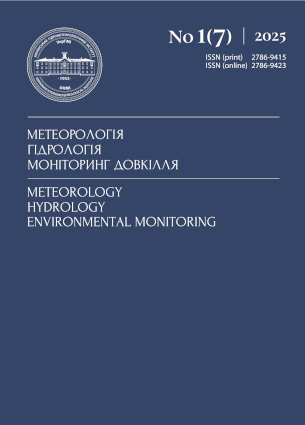HYDROGRAPHY AND WATER RESOURCES OF MOLDOVA: CONDITION, USE, MANAGEMENT
Taras Shevchenko National University of Kyiv, Kyiv, Ukraine
https://orcid.org/0000-0001-7643-0304
Gherman Bejenaru
State hydrometeorological service, Chișinău, Republic of Moldova
https://orcid.org/0000-0001-6340-9602
Vasyl Grebin
Taras Shevchenko National University of Kyiv, Kyiv, Ukraine
https://orcid.org/0000-0001-8197-607X
Abstract
References
1. Agreement between the Cabinet of Ministers of Ukraine and the Government of the Republic of Moldova on cooperation in the field of protection and sustainable development of the Dniester River basin. June 7, 2017. [in Ukrainian]. Retrieved January 3, 2025 from https://zakon.rada.gov.ua/laws/show/498_165-12#n">https://zakon.rada.gov.ua/laws/show/498_165-12#n
2. Agreement between the Government of Romania and the Government of the Republic of Moldova regarding cooperation for the protection and sustainable use of the Prut and Danube waters. June 28, 2010. [In Romanian]. Retrieved January 3, 2025 from https://gov.md/sites/default/files/document/attachments/nu-1193-mm-2023.pdf">https://gov.md/sites/default/files/document/attachments/nu-1193-mm-2023.pdf
3. Aquastat – FAO (2021). Country Profile – Republic of Moldova. Retrieved December 24, 2024 from https://www.fao.org/aquastat/en/countries-and-basins/country-profiles/country/MDA">https://www.fao.org/aquastat/en/countries-and-basins/country-profiles/country/MDA
4. Aleksandrov, B., Afanasyev, S., Bejan, Yu. et al. (2019). Transboundary diagnostic analysis of the Dniester River basin. Chișinău - Kyiv,155 p. [in Russian]
5. 'Apele Moldovei' Agency (2024). Official site. [In Romanian]. Retrieved December 24, 2024 from https://apelemoldovei.gov.md/">https://apelemoldovei.gov.md/
6. 'Apele Moldovei' Agency, reorganized. Three new Directorates will be created. 18.12.2024. [In Romanian]. Retrieved January 3, 2025 from https https://stiri.md/article/social/agentia-apele-moldovei-reorganizata-vor-fi-create-trei-directii-noi
7. Bejenaru, G., Dilan, V. (2022). Assessment of the water resources of small rivers in the Republic of Moldova. Case study – Răut River. Present Environment and Sustainable Development, 16(2), 15-24.
8. Bejenaru, G., Melniciuc, O. (2016). Assessment of changes in water resources of the rivers of the Republic of Moldova under the influence of agrotechnical measures. Cadastre and Law, 46, 187-190. [in Russian]
9. Bejenaru, G., Mardari, V. (2024). Modificarea resurselor de apă pe teritoriul Republicii Moldova prin prisma schimbărilor climatice. SHS. [In Romanian]. Retrieved December 24, 2024 from https://meteo.md/images/uploads/clima/researches/Evaluarea_resurselor_de_apa_MG.pdf
10. Burduja, D., Bacal, P. (2022). Evaluation of the use and management of the water resources of the Republic of Moldova. Case study: RD Nord. Chişinău, 200 р. [In Romanian]
11. Capcelea, V. (2024). Physical geography of the Republic of Moldova. Chişinău, 246 p. [In Romanian]
12. Depositphotos. Moldova-vector-map (2025). Retrieved January 3, 2025 from https://depositphotos.com/ua/vector/republic-of-moldova-vector-map-11312688.html
13. Directive 2000/60/EC of the European Parliament and of the Council of 23 October 2000 establishing a framework for Community action in the field of water policy. [in Ukrainian]. Retrieved January 3, 2025 from https://zakon.rada.gov.ua/laws/show/994_962#Text
14. Duca, G. (2010). Water management in the Republic of Moldova. Expertise A.S.M. Akademos, 2(17), 26–27. [In Romanian]
15. Environment Agency. Ministry of the Environment (2025). Official site. [In Romanian]. Retrieved January 3, 2025 from https://am.gov.md/
16. Falkenmark, M. (2003). Freshwater as shared between society and ecosystems: From divided approaches to integrated challenges. Philosophical Transactions Royal Society London, 358, 2037–2049. https://doi.org/10.1098/rstb.2003.1386.
17. Government Decision Republic of Moldova No. HG814/2017 of 17.10.2017 regarding the approval of the Management Plan of the Dniester river basin district. [In Romanian]. Retrieved January 3, 2025 from https://faolex.fao.org/docs/pdf/mol221277.pdf
18. Government Decision Republic of Moldova No. HG955/2018 of 03.10.2018 regarding the approval of the Management Plan of the Danube-Prut and Black Sea river basin district. [In Romanian]. Retrieved January 3, 2025 from https://faolex.fao.org/docs/pdf/mol221278.pdf
19. International Security and Partnership Centre (2024). Retrieved December 24, 2024 from https://www.ispc.org.ua/archives/746
20. Khilchevskyi, V.K. (2023). Hydrography and water resources of Europe. Kyiv: DIA, 308 p. [in Ukrainian]
21. Jeleapov, A. (2022b). The water resources of the rivers within the Norda Development Region of the Republic of Moldova. Bulletin of the Academy of Sciences of Moldova. Life Sciences, 1(345), 109-117. [In Romanian]
22. Khilchevskyi, V.K., Grebin, V.V. (2017). Hydrographic and water management zoning of the territory of Ukraine, approved in 2016. – implementation of the provisions of the EU WFD. Hydrology, hydrochemistry and hydroecology, 1(44), 8–20. [in Ukrainian]
23. Melniciuc, O., Jeleapov, A., Crăciun, A., Bejenaru, G. (2019). The minimum admissible water resources of the Republic of Moldova. Bulletin of the Academy of Sciences of Moldova. Life sciences. 3(339), 135-144. [In Romanian]
24. Ministry of the Environment of the Republic of Moldova (2025). Official site. [In Romanian]. Retrieved January 3, 2025 from https://mediu.gov.md/
25. National Environmental Center (2025). Water resources management. [In Romanian]. Retrieved January 3, 2025 from https://environment.md/ro/managementul_resurselor_de_apa
26. Sirodoev, G., Corobov, R., Trombitki, I., Cazac, V., Cantîr, A. (2017). Evaluation of water resources in the hydrographic basins of small rivers in the context of environmental changes (case study Bălțata). Bulletin of the Institute of Geology and Seismology of the ASM, 1, 90-98. [In Romanian].
27. State Enterprise Hydrogeological Expedition from Moldova (2025). Official site. [In Romanian]. Retrieved January 3, 2025 from https://ehgeom.gov.md/ro/
28. State Hydrometeorological Service (2025). Official site. [In Romanian]. Retrieved January 3, 2025 from https://www.meteo.md/index.php/despre-noi/
29. Statistical yearbook of the Republic of Moldova (2023). Chişinău, 587 p. [In Romanian]
30. Trombitski, I. Ed. (2018). Guide (methodological guideline) for the management of small and medium-sized river basins. Working group: R. Melian et al.Chişinău, Eco-Tiras, 84 p.
31. Water Law No. 272/23.12.2011 Republic of Moldova. [In Romanian] Retrieved January 3, 2025 from https://www.legis.md/cautare/getResults?doc_id=23003&lang=ro
32. Worldometer. Moldova – Water (2024). Retrieved December 24, 2024 from https://www.worldometers.info/water/moldova-water/

